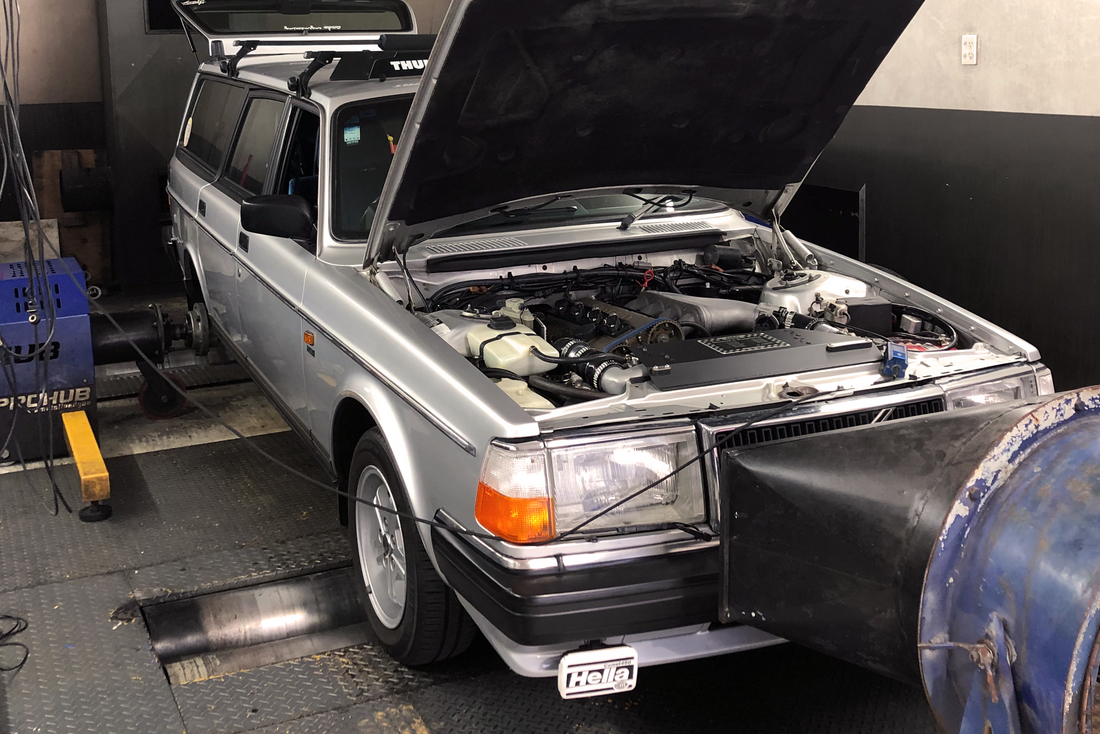
Volvo 240 16v Tuning: Part 1
Share
Dyno Results
Let’s start with what everyone wants to see dyno results.
We’ll get into more detail in Parts 2 and 3.
Context matters as much as the numbers. This project is about developing a realistic, street-driven 16-valve turbo package for a right-hand-drive Volvo 240 that other enthusiasts can replicate.
This car serves as a test bed for our own components including the Ando Engineering coil conversion bracket, and both our intake and exhaust manifolds designed specifically for the 16-valve platform. The goal was as much about proving our products in a real-world environment as it was about exploring the performance potential of the B230 block and 16-valve head combination. We wanted to find the limits ourself and see what this engine is capable of in basic form.
We’re proud to report that our parts performed flawlessly throughout the entire testing process. We’ll dive deeper into the limitations of the rest of the package, including the factory driveline and other supporting systems in Parts 2 and 3 of this series.

Build Constraints
1. Factory Components: Retain as many stock systems as possible to keep the conversion practical and reliable.
2. Factory Gearbox: The car still runs the original M47 five-speed. It’s not ideal for big torque, but useful for testing the limits of the factory driveline.
3. Factory Camshafts: The head remains stock, with only upgraded valve springs. We wanted to see what the standard 16V setup could do before changing anything.
4. Pump Fuel: Tuned exclusively on BP 98 (98 RON) pump gas. E85 is hard to find locally, and since this is a street car, pump fuel was the logical choice.
For reference, NZ BP 98 RON roughly equals 93 AKI in the US.
Tuning Philosophy
There’s no single “right way” to tune a street car, every tuner has their own approach.
Ours focuses on usable performance and reliability: strong power across the rev range that complements factory gearing and feels responsive everywhere, not just flat-out.
Making power low in the revs increases mechanical stress. While the Redblock and forged internals can handle it, the factory gearbox is still a weak link. To protect it, we used several torque-management strategies to soften the initial hit while still exploring the engine’s full potential.
The Dyno Session
After several weeks of street tuning and shakedown testing, the car spent seven hours on a Mainline hub dyno. The tune was already about 90 percent complete; this session was for data gathering and validation, learning the engine’s strengths and weaknesses first-hand.
We used a mix of steady-state load tuning and long ramp-rate runs to capture consistent, repeatable data and understand how the engine responded under sustained load. The dyno results provided the foundation for future refinements.
Every run was logged in Haltech software, giving us data to review and revise away from the dyno. What you see here represents our test session, not the final tune.
Dyno Results
In New Zealand we work in metric units Kilowatts and Newton meters but for some reason we all use psi for pressure when it comes to cars. dont ask me why.
298.8kw is 400hp at the wheels for reference.
The dynograph shows hub speed, not engine RPM, so we added some reference points from the Haltech log:
· 5 psi @ 2,700 RPM
· 10 psi @ 3,200 RPM
· 15 psi @ 3,700 RPM
· 20 psi @ 4,300 RPM
These figures show how the Garrett G30-660 delivers boost with a broad, responsive powerband exactly what we wanted for a street setup.
Notice the shape of the top line, the torque curve. It reflects the efficiency of the factory camshafts and gives us insight into the engine’s volumetric efficiency.
We began testing with a 6,800 RPM limit, later raised to 7,000 RPM. With its long rod ratio and upgraded valve springs, the engine could safely rev higher, but we kept it conservative for reasons we’ll cover in Part 2.
For reference 300kw at the wheels is respectable power on this dyno for an unopened 1jz or rb25 engine, usually with standalone ecu and upgraded turbo when on 98RON fuel. considering those engines are 2.5L this 2.3L Volvo engine performs well.
Next: In Part 2: Limitations, we’ll break down the factors that shaped these results, what we discovered during testing
